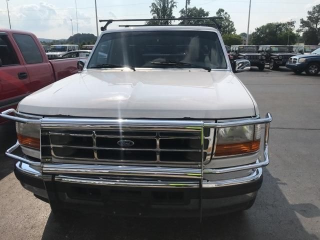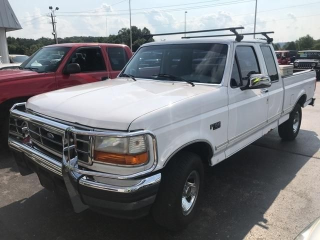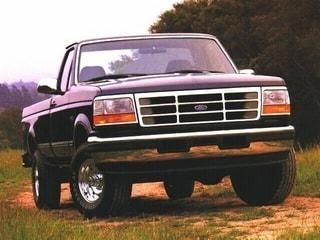The 1996 Ford F-150 is part of the ninth generation (1992-1996) of Ford's iconic F-Series trucks. It's available in regular cab, SuperCab (extended cab), and styleside or flareside (stepside) body styles. Key trims included the base XL, mid-range XLT, and luxurious Eddie Bauer. New prices ranged from around $15,000 to $25,000. It's popular for its dependability, ruggedness, and wide range of configurations to suit various needs.
The Good
The 1996 Ford F-150 offers robust performance and proven reliability, appealing to practical buyers. It provides a comfortable ride for a truck of its era. Its classic, muscular design evokes nostalgia. For emotional buyers, its dependability represents freedom and capability. It's also considered a good value on the used market.
The Bad
Known weaknesses of the 1996 Ford F-150 include potential rust issues, particularly in areas with road salt. The automatic transmission can sometimes exhibit problems. Certain engine options can suffer from spark plug issues. Fuel economy is not a strong point. Check for worn suspension components and general wear and tear due to age.
1996 Ford F-150: Quick Overview
- Engine Options:
- 4.9L Inline-6 (300 CID): Around 150 horsepower
- 5.0L V8 (302 CID): Around 205 horsepower
- 5.8L V8 (351 CID): Around 210 horsepower
- Horsepower: Varies by engine, ranging from approximately 150 to 210 hp.
- Fuel Economy:
- 4.9L I6: 14-18 mpg city / 18-22 mpg highway (estimated)
- 5.0L V8: 13-17 mpg city / 17-21 mpg highway (estimated)
- 5.8L V8: 12-16 mpg city / 16-20 mpg highway (estimated)
- 0-60 Times: Not a primary focus for this truck, estimated between 9-12 seconds depending on engine and configuration.
- Towing Capacity: Varies significantly based on engine, cab configuration, and rear axle ratio. Could range from approximately 4,000 lbs to over 7,000 lbs.
- Trim-Level Features:
- XL: Base model; vinyl seats, basic AM/FM radio, manual windows/locks.
- XLT: Cloth seats, upgraded audio system, power windows/locks, chrome exterior trim.
- Eddie Bauer: Two-tone paint, premium cloth or leather seats, upgraded interior trim, available four-wheel drive.
- Transmissions:
- 5-speed manual
- 4-speed automatic
1996 Ford F-150 Specifications
Vehicle Information
| Year | 1996 |
| Make | Ford |
| Model | F-150 |
| Trim | - |
| Style | - |
| Type | Truck |
| Category | Standard Pickup Truck |
Manufacturing Details
| Made In | Mexico |
| Manufacturing City | CUAUTITLAN |
Dimensions
| Doors | 2-Door |
| Curb Weight | 3886 pounds |
| Gross Vehicle Weight Rating | 7000 pounds |
| Overall Height | - |
| Overall Length | - |
| Overall Width | - |
| Wheelbase Length | - |
| Standard Seating | - |
Engine & Performance
| Engine | DDC-60 |
| Engine Size | 4.9L |
| Engine Cylinders | 6 |
| Transmission | 4-Speed Automatic |
| Transmission Type | Automatic |
| Transmission Speeds | 4-Speed |
| Drivetrain | Rear-Wheel Drive |
Additional Features
| Anti-Brake System | - |
| Steering Type | - |
Pricing
| Manufacturer Suggested Retail Price (MSRP) | - |
| Invoice Price | - |
| Delivery Charges | - |
Vehicle History Report
Vehicle
Specifications
Specifications
Ownership
History
History
All History
Events
Events
NMVTIS Title
History Check
History Check
Salvage/Rebuilt
Check
Check
Accident
Check
Check
Theft
Check
Check
Open Lien
Check
Check
Past Sale
Listings
Listings
Safety
Recalls
Recalls
Odometer
Check
Check
Market Price
Analysis
Analysis
What Problems Does the 1996 Ford F-150 Have?
Frequently reported problems for the 1996 Ford F-150 include issues with the automatic transmission, particularly slipping or harsh shifting. Rust is a common concern, especially in areas that use road salt. The 4.9L inline-six engine is generally considered very reliable, but the 5.0L and 5.8L V8 engines can experience spark plug issues, potentially leading to misfires.
Long-term reliability concerns often revolve around wear and tear of suspension components, such as ball joints and bushings. The electronic components, like the engine control module (ECM), can also fail over time.
Recalls have been issued for various F-150 models over the years, though not necessarily specific to the 1996 model year. It's essential to check the NHTSA (National Highway Traffic Safety Administration) website for any applicable recalls based on the specific VIN of the vehicle.
Common complaints also involve the failure of the fuel pump and issues with the air conditioning system. Regular maintenance and addressing minor problems promptly can help extend the lifespan of the truck, but inherent weaknesses related to age and wear are inevitable.
Long-term reliability concerns often revolve around wear and tear of suspension components, such as ball joints and bushings. The electronic components, like the engine control module (ECM), can also fail over time.
Recalls have been issued for various F-150 models over the years, though not necessarily specific to the 1996 model year. It's essential to check the NHTSA (National Highway Traffic Safety Administration) website for any applicable recalls based on the specific VIN of the vehicle.
Common complaints also involve the failure of the fuel pump and issues with the air conditioning system. Regular maintenance and addressing minor problems promptly can help extend the lifespan of the truck, but inherent weaknesses related to age and wear are inevitable.
How long will the 1996 Ford F-150 last?
A well-maintained 1996 Ford F-150 can easily exceed 200,000 miles and potentially reach 300,000+ miles with diligent care. Years of service depend heavily on usage. Trucks used primarily for light-duty tasks will last longer than those subjected to heavy towing or off-road use. Regular oil changes, transmission servicing, and addressing rust are crucial for longevity.
Long-term durability is generally good, but weaknesses include rust susceptibility (especially in northern climates), potential transmission issues, and wear of suspension components. Properly maintained, these trucks can provide many years of reliable service, but neglect will significantly shorten their lifespan.
Long-term durability is generally good, but weaknesses include rust susceptibility (especially in northern climates), potential transmission issues, and wear of suspension components. Properly maintained, these trucks can provide many years of reliable service, but neglect will significantly shorten their lifespan.
What Technology & Safety Features are Included?
The 1996 Ford F-150 featured relatively basic tech and safety features compared to modern vehicles. Entertainment was typically limited to an AM/FM radio, with optional cassette players or CD players available. Higher trims like the XLT and Eddie Bauer offered upgraded sound systems.
Driver-assistance features were minimal, primarily consisting of power steering and power brakes. There were no advanced driver-assistance systems (ADAS) like lane departure warning or automatic emergency braking.
Safety features included standard seatbelts and front airbags. Anti-lock brakes (ABS) were available as an option.
Crash-test ratings from the NHTSA are available, although results should be viewed in the context of vehicles from that era. Ratings typically varied depending on cab configuration. Expect moderate scores, but far below the safety standards of modern vehicles.
Optional features included air conditioning, cruise control, power windows and locks, and upgraded interior materials. Overall, the 1996 F-150 prioritized ruggedness and functionality over advanced technology and extensive safety features.
Driver-assistance features were minimal, primarily consisting of power steering and power brakes. There were no advanced driver-assistance systems (ADAS) like lane departure warning or automatic emergency braking.
Safety features included standard seatbelts and front airbags. Anti-lock brakes (ABS) were available as an option.
Crash-test ratings from the NHTSA are available, although results should be viewed in the context of vehicles from that era. Ratings typically varied depending on cab configuration. Expect moderate scores, but far below the safety standards of modern vehicles.
Optional features included air conditioning, cruise control, power windows and locks, and upgraded interior materials. Overall, the 1996 F-150 prioritized ruggedness and functionality over advanced technology and extensive safety features.
What Colors Options are Available?
Exterior Colors
Oxford White
Raven Black
Bright Red
Medium Wedgewood Blue
Cayman Green Metallic
Silver Metallic
Royal Blue Metallic
Interior Colors
Light Saddle
Dark Charcoal
1996 Ford F-150 Prices and Market Value
When new, the 1996 Ford F-150 ranged in price from approximately $15,000 for a base XL model to around $25,000 for a fully equipped Eddie Bauer. On the current used market, prices vary widely depending on condition, mileage, and location, ranging from $2,000 to $10,000 or more.
Depreciation has been significant, as expected for a vehicle of this age. Resale value is primarily influenced by condition, engine type (the 4.9L I6 and 5.0L V8 are typically more desirable), and whether it's 4x4. Trucks in excellent condition with low mileage command a premium. Rust-free examples are particularly valuable.
Depreciation has been significant, as expected for a vehicle of this age. Resale value is primarily influenced by condition, engine type (the 4.9L I6 and 5.0L V8 are typically more desirable), and whether it's 4x4. Trucks in excellent condition with low mileage command a premium. Rust-free examples are particularly valuable.
1996 Ford F-150 Cost of Ownership
Insurance costs for a 1996 Ford F-150 are generally lower than newer vehicles due to its age. Fuel economy is poor, making fuel a significant ongoing expense. Maintenance costs can be moderate if the truck has been well-maintained, but repairs can become costly as components age and fail. Parts availability is generally good.
Long-term ownership costs depend heavily on the truck's condition. A well-maintained example might be relatively economical, while a neglected one can become quite costly due to frequent repairs.
Long-term ownership costs depend heavily on the truck's condition. A well-maintained example might be relatively economical, while a neglected one can become quite costly due to frequent repairs.
1996 Ford F-150 Fuel Efficiency
Fuel Type
Gasoline
Fuel Capacity
34.7 gallons
City Mileage
14 miles/gallon
Highway Mileage
18 miles/gallon
1996 Ford F-150 Safety Rating
NHTSA
IIHS
1996 Ford F-150 Insurance
Insurance for a 1996 Ford F-150 is moderately priced, reflecting its status as a Truck with strong safety ratings and
reasonable repair costs.
reasonable repair costs.
How Does the 1996 Ford F-150 Compare to Other Truck?
The 1996 Ford F-150 competed with trucks like the Chevrolet C/K 1500, Dodge Ram 1500, and Toyota T100. In terms of performance, the F-150's V8 engines were comparable to Chevy's, while the Dodge Ram offered a more powerful V10 option. The Toyota T100, while reliable, lacked the towing capacity of the domestic trucks.
Features were relatively similar across these trucks, with optional power equipment and upgraded interiors on higher trims. Reliability is a mixed bag; the Ford's 4.9L I6 is known for its robustness, but the automatic transmissions in all these trucks can be a weak point. The Toyota T100 arguably offered superior long-term reliability.
Price-wise, the F-150 was generally competitive. On the used market, similar trucks are often priced similarly, making condition the primary differentiator.
Alternatives? The Chevrolet C/K 1500 offers a similar experience. The Toyota T100, if towing capacity is not a major concern, provides better reliability. A newer, more modern truck might be a better choice for buyers prioritizing safety and technology.
Features were relatively similar across these trucks, with optional power equipment and upgraded interiors on higher trims. Reliability is a mixed bag; the Ford's 4.9L I6 is known for its robustness, but the automatic transmissions in all these trucks can be a weak point. The Toyota T100 arguably offered superior long-term reliability.
Price-wise, the F-150 was generally competitive. On the used market, similar trucks are often priced similarly, making condition the primary differentiator.
Alternatives? The Chevrolet C/K 1500 offers a similar experience. The Toyota T100, if towing capacity is not a major concern, provides better reliability. A newer, more modern truck might be a better choice for buyers prioritizing safety and technology.
Final Verdict: Is the 1996 Ford F-150 a Good Truck?
The 1996 Ford F-150 is ideal for someone seeking a simple, reliable, and affordable used truck for light-duty tasks. It's a good choice for DIY enthusiasts who are comfortable with basic maintenance and repairs. It's worth buying if you find a well-maintained example with low mileage and minimal rust.
The 4.9L inline-six engine is preferable for its durability. Avoid trucks with significant rust or transmission problems. Given its age, it's only worth buying used. It's not recommended for those prioritizing safety, fuel efficiency, or modern technology.
The 4.9L inline-six engine is preferable for its durability. Avoid trucks with significant rust or transmission problems. Given its age, it's only worth buying used. It's not recommended for those prioritizing safety, fuel efficiency, or modern technology.



